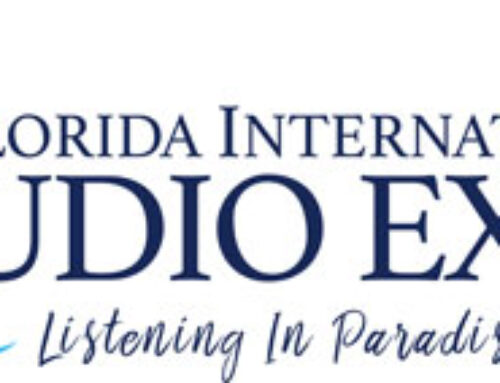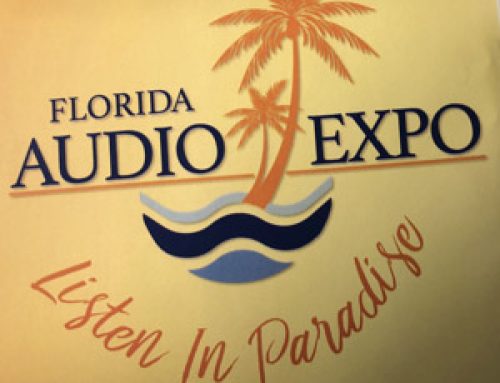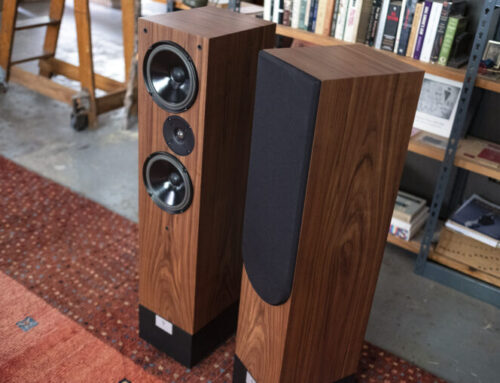The Border Patrol S20 power amplifier and Control Unit pre-amplifier.
 Border Patrol seems like a reasonable enough name for a valve amp manufacturer these days, but twelve years ago when the name was used for a rather unusual green valve power amp (with PX4 output tubes if memory serves) made by then Audio Innovations employee Guy Sergeant it was a source of some amusement. It was also dubbed the Big Ten, another humorous reference to the fact that it produced nine watts but one which back fired when Guy’s employers heard about it, whence the name reverted to BT for big trouble!
Border Patrol seems like a reasonable enough name for a valve amp manufacturer these days, but twelve years ago when the name was used for a rather unusual green valve power amp (with PX4 output tubes if memory serves) made by then Audio Innovations employee Guy Sergeant it was a source of some amusement. It was also dubbed the Big Ten, another humorous reference to the fact that it produced nine watts but one which back fired when Guy’s employers heard about it, whence the name reverted to BT for big trouble!
What became of the green amp is lost in the mists of audiophile time, which while slower than real time is no easier to keep track of, but the name has lived on thanks to the efforts of one time Audio Innovations retailer Gary Dews who used to run the southern arm of the small but passionate Definitive Audio retail collective.
Gary made his first Border Patrol in 1993 but the brand didn’t come of age and until the first silk screened models in ‘97. Since then BP has produced a number of variations on the power amp theme as well as some of the meatiest external power supplies in the valve kingdom. The latter re-introduced the notion of valve rectified choke input filtering to the hi-fi world and go some way to explaining why Border Patrol amps tend not to sound like traditional valve amps in as much as they do bass with no little conviction.
A quick look around the BP website will reveal that there are numerous ways to use the popular 300B triode output tubes that feature on this and most other BP designs. There are pure single ended designs with one output tube per channel and so called push pull versions with two output tubes per channel which are technically, but not necessarily sonically, superior to the parallel single ended arrangement found on the S20. Paralleled output tubes amplify the whole signal for one channel, the effect being a slightly greater than doubling of the usual 7.5 watts offered by 300B valves. There are pros and cons to each configuration but in purist terms the hierarchy goes: single ended, parallel single ended, push pull. One reason not to build a single ended amp is that the output transformers have to be considerably larger than the equivalent push-pull– those aren’t mains transformers at the back of the S20 – because there is a continuous DC flow through the transformer which therefore needs a much larger magnetic core and an air gap to prevent saturation. Border Patrol designs all of its own transformers to ensure that results are not compromised by this critical stage in the chain.
The S20 is a fully hard wired, all triode, class A design. It uses an input driver valve that has high gain, low impedance and high transconductance. The latter in simple terms indicates sensitivity and used to be referred to as the ‘goodness factor’, greater sensitivity being A Good Thing in almost all high fidelity components. The other good thing you need in any amp is a decent power supply, the S20 being dual mono all the way back to the mains socket, has two very hefty supplies feeding the requisite voltages to the amplifier via meaty multipin connectors. Quite conveniently both supplies and the amp itself are powered up with a single switch, less conveniently this switch is located behind one of the supplies, and as this baby runs very warm indeed, you won’t feel inclined to leave it on all the time unless the central heating has packed up.
You get a choice of output valve with all BP’s. This sample came with TJ Full Music mesh-plate 300Bs, but both less and more expensive options are available, assuming that is, that Western Electric resolve the supply problems for its legendary 300Bs.
The matching pre-amp, or Control Unit as BP dubs it, is actually a prototype and full production units are expected in September and will bear an LED to indicate power on. It uses a 5687 triode valve in anode follower configuration with no negative feedback, the circuitry being fully hardwired as in the S20. The power supply also mirrors the power amp in being valve rectified with choke input filtering. A 24 position step attenuator is used to control volume and is combined with a five input selector for the line inputs on the back, these are joined by tape- and two pre- outs.
Performance We used the Border Patrol combo with Living Voice Avatar OBX-R speakers, a combination that works well because of the decent sensitivity of the speakers and a similar approach to sound reproduction, by which we mean that both brands value dynamics and timbral resolve more than other high fidelity virtues. If you can get these two things right everything else seems to fall into place, timing for instance, is very good – this is a nimble or agile amplifier that keeps up with everything you throw at it. It reminds you of why Quicksilver was such a good name for a valve amp brand. What you get alongside the speed is rather unvalve-like bass power. Those two power supplies are damn ‘stiff’ as they say in the trade, and allow the essentially low power output devices to deliver some serious grunt.
Because this is SET grunt it reveals all the colour and shape of bass notes in a tuneful and dynamic fashion. The majority of SET’s sound distinctly lame compared to the Border Patrol; this is a triode amp for those reared on transistor bass. Stick on some Outkast and you’ll know all about the instrumentation, recording and processing of the sounds used to produce the bass, the low synth bass on the track Love Hater being a good example.
Another atypical aspect of this amp is its response. Valves are famous for having a glorious midband and a tendency to emphasise this above all else. The S20 while phenomenally transparent in the mid-band has a remarkably flat response. You don’t miss out of the frequency extremes with it This is a wide band amplifier!
The midband is proper SET stuff though, voices are superb and you can hear all the words all of the time. This is a fluid and revealing amp that combines a delicacy that lets you hear micro dynamics clearly with an ability to swing real energy when it’s required. At the end of the day 18 watts is still 18 watts and you don’t get the power that a similarly priced transistor design can offer, but the way tracks like Deep Purple’s Never Before pump with energy and colour is extremely beguiling, and even if you push the level hard, the way it clips is actually rather nice with material like this. When a tranny amp clips the distortion produced is pretty offensive whereas a valve design on the other hand can actually sound quite good. That’s why many electric guitar players still prefer valves in their amps.
The Border Patrols are also very strong when it comes to producing three dimensional notes in a soundstage that is as deep as they come, the sampled and treated sounds on Fourtet’s Rounds are positively solid yet never static. The way that Kieren Hebden uses reverb and declining level to slowly pull the music away from the listener as track 1 fades out is extremely well put with the BP’s. This quality also applies to the recreation of acoustic space. This is not one of those blowsy valve amps that makes everything enormous, it’s a precisely focussed device, but when something comes along with height information such as a track from Bugge Wesseltoft’s Filming where there is the twitter of birds sitting way above the groove creation of the band, all is clear. What’s more the resolution of small sounds is so good that you can precisely identify what the sources for all those sounds are – sparrows methinks.
The track Clear Spot from Captain Beefheart’s album of the same name has gorgeous ‘phat’ bass lines, colour, life and energy with no apparent shortage of grunt in the BP’s capable hands. It’s a lovely meaty sound which majors on grin factor, Don van Vliet’s elastic blues works a treat with this level of attention to timing and energy. Technically speaking, single-ended valve amps are meant to produce lots of second order harmonic distortion, but if this is distortion – bring it on.
The Border Patrol amps are impressively well built, attention to detail is high and you get the impression that valves aside they would give more than a lifetime’s service. This combined with their glorious energy, drive and resolve makes them superb value and a sure fire way to get to the heart of your music collection.




Leave A Comment